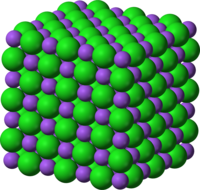
Photo from wikipedia
A statistical analysis of internal stress fluctuations, defined as the difference between the local mean stress and stress on dislocations, is presented for deforming crystals with 3D discrete dislocation systems.… Click to show full abstract
A statistical analysis of internal stress fluctuations, defined as the difference between the local mean stress and stress on dislocations, is presented for deforming crystals with 3D discrete dislocation systems. Dislocation realizations are generated using dislocation dynamics simulations and the associated stress field is computed as a superposition of a regularized stress field of dislocation lines within the domain of the solution and a complementary stress field computed via a finite-element boundary value problem. The internal stress fluctuations of interest are defined by an ensemble of the difference between the stress on dislocation lines and the local mean field stress in the crystal. The latter is established in a piecewise fashion over small voxels in the crystal thus allowing the difference between the local average stress and stress on segments to be easily estimated. The results show that the Schmid stress (resolved shear stress) and Escaig stress fluctuations on various slip systems sampled over a random set of points follow a Cauchy (Lorentz) distribution at all strain levels, with the amplitude and width of the distribution being dependent on the strain. The implications of the Schmid and Escaig internal stress fluctuations are discussed from the points of view of dislocation cross-slip and the dislocation motion in continuum dislocation dynamics.
Journal Title: Modelling and Simulation in Materials Science and Engineering
Year Published: 2022
Link to full text (if available)
Share on Social Media: Sign Up to like & get
recommendations!